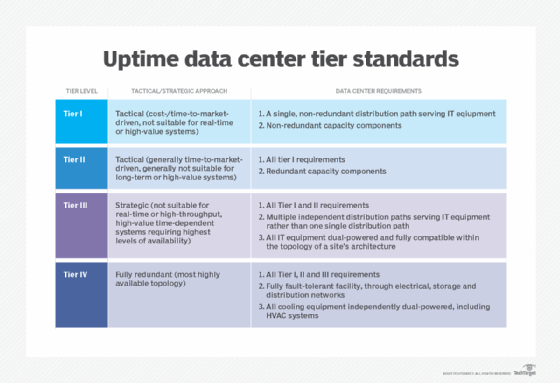Uptime Institute's data center tier standards
What are data center tiers?
Data center tiers are a system created by Uptime Institute LLC to describe the availability of infrastructure resources in a facility. A division of 451 Group, the Uptime Institute is the standard for this certification effort, which defines what is required to ensure that data centers meet an organization's business demands. The tiering system came into place in the mid-1990s, making choosing a data center design and construction, whether it be public or private, a lot easier when it comes to predicted uptime and availability.
There are four tiers, ranked by Roman numerals from Tier I -- the most basic data center design meeting the Institute's core requirements -- to Tier IV -- the most fault-tolerant and available data center design. Note that only Roman lettering is allowed; any data center advertising itself with Arabic numerals -- Tier 3, for example -- should be reviewed as it might not be certified by the Uptime Institute.
As the tier levels increase, organizations must make bigger investments to meet certification criteria. Organizations should prepare a risk assessment that balances business risk against cost and use this to decide which tier is right for them. The Uptime Institute has its own professional services group that can help organizations prepare such assessments and then provide help to design the facility.
What are the factors considered for data center tier classification?
The Uptime Institute assesses a data center facility or its design documents before allowing any organization to claim a tier classification. Tier Certification of Design Documents checks an organization's design documents against the Uptime Institute's criteria and then awards a tier classification based on that information. Tier Certification of Constructed Facility then ensures the facility has been built accurately against the design documents. Finally, Tier Certification of Operational Sustainability (TCOS) measures the capability of a facility to operate and meet expected availability and efficiency levels. All facilities with a tier classification are then listed on the Uptime Institute's website. There are currently more than 1,700 certifications across 98 countries.
Tier classifications focus mainly on platform availability. Areas of consideration include the following:
- Power. What level of power redundancy is in place, not just within the data center, but from the grid to the facility?
- Cooling. Does the facility have enough cooling to meet the needs of critical areas of the platform? Is this cooling matched with redundancy? Is there any room for overhead?
- Maintenance. Can the environment be maintained as planned and without significant, or any, downtime?
- Fault management capabilities. Is the entire platform capable of surviving the failure of one or more components without affecting IT systems?
What are the different data center tiers?
The Uptime Institute tiers are defined as follows:
- Tier I (basic capacity)
- uninterruptible power supply (UPS) to survive basic power outages, power sags and power spikes;
- dedicated area for IT systems;
- dedicated cooling systems that operate 24/7; and
- diesel or gas generator to cover longer power outages than the UPS can manage.
- Tier II (redundant capacity). Builds on Tier I by adding more power resiliency.
- engine generators, including fuel tanks to hold enough fuel to keep generators running for a longer period;
- energy storage that enables the organization to switch from grid power services to engine power generation;
- dedicated chillers or other cooling units, rather than simple air conditioning units; and
- heat rejection equipment that enables heat to be removed more effectively than with simple air conditioning.
- Tier III (concurrently maintainable). Builds on Tier II capabilities to provide enhanced platform availability.
- concurrent maintainability through use of redundant components; and
- use of redundant power distribution paths.
- Tier IV (fault-tolerant). Provides the ultimate in platform resiliency by building on the previous tiers.
- multiple independent and isolated systems that provide redundant capacity and power distribution.
How do the different tiers compare?
Tier I data centers provide a competent environment with basic protection against systems failure and a degree of redundancy to manage power outages. However, these facilities don't have resilience when it comes to equipment failure.
Tier II facilities provide much greater protection against power outages through generation redundancies, as well as enhanced storage of fuel and possibly energy.
Tier III facilities offer concurrent maintainability; this means the facility doesn't have to shut down to replace key equipment, as there is enough equipment redundancy to enable planned and unplanned maintenance.
Tier IV facilities provide the ultimate in fault tolerance: Everything is dual-powered; redundant electrical, distribution and storage systems are available; and highly redundant server and network architectures are in place. Tier IV facilities should survive any failure, provided there is enough fuel to fill the facility's generators and areas outside the data center owner's control, such as public networks, are available.

Choosing the right data center tier
Many small and medium-sized businesses that have outgrown an office-based IT system -- a few servers and simple PC/laptop network, for example -- find that a move to a Tier II, Tier III or Tier IV facility is expensive. A Tier I facility, which can be created by converting existing space within many office environments, is often enough in these situations.
For those organizations where downtime is more of an issue and where power outages are relatively common, a Tier II facility makes more sense, as it builds in more power fault tolerance.
When availability of the overall IT platform is more of an issue, Tier III offers systems redundancy with a strong capability to maintain a high availability platform.

Tier IV is for organizations where availability is nonnegotiable -- for example, high-throughput financial systems or national security systems. While costly, this tier is a good investment as equipment should always be available. However, Tier IV is based on single overall redundancy at all points, so the failure of one piece of equipment can become an opportunity for systems failure should a second item fail while the first is being replaced.
To get around this issue, the Uptime Institute offers further levels of certification using bronze, silver and gold TCOS levels. These levels recognize how facility owners have gone beyond the basic tier classifications, for example, by adding three-way redundancy to their platforms.
Data center owners who don't believe they can easily move the existing facility toward a tier facility can take advantage of the Uptime Institute's professional services to see what would be required. The Institute also offers a separate service that performs an operational assessment that can lead to a Management & Operations Stamp of Approval rating.








